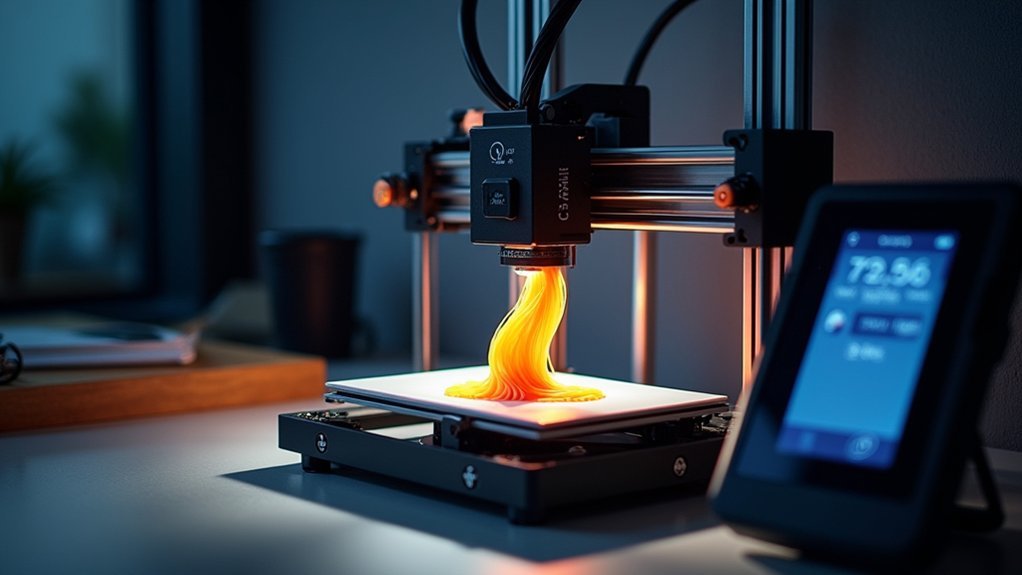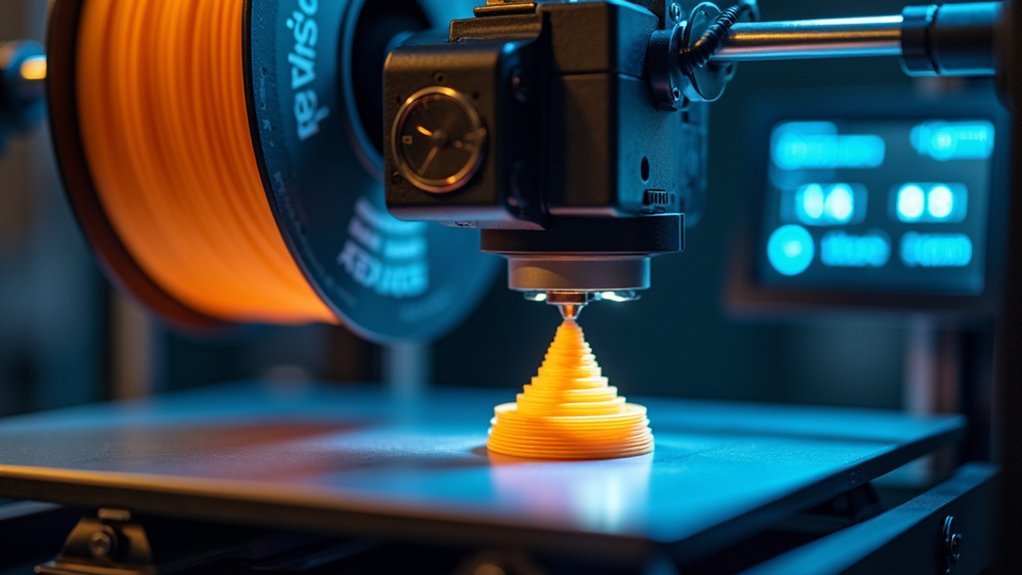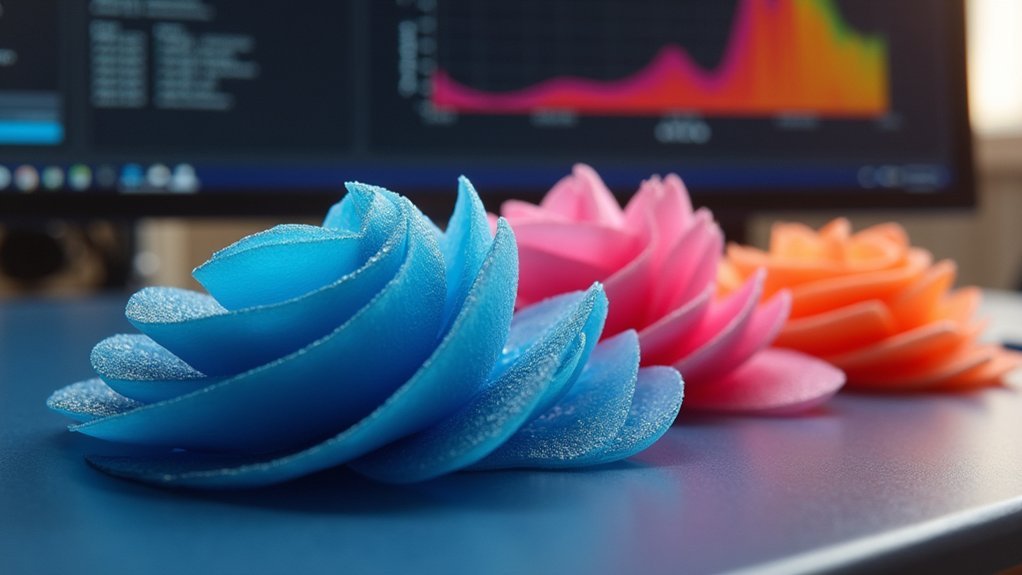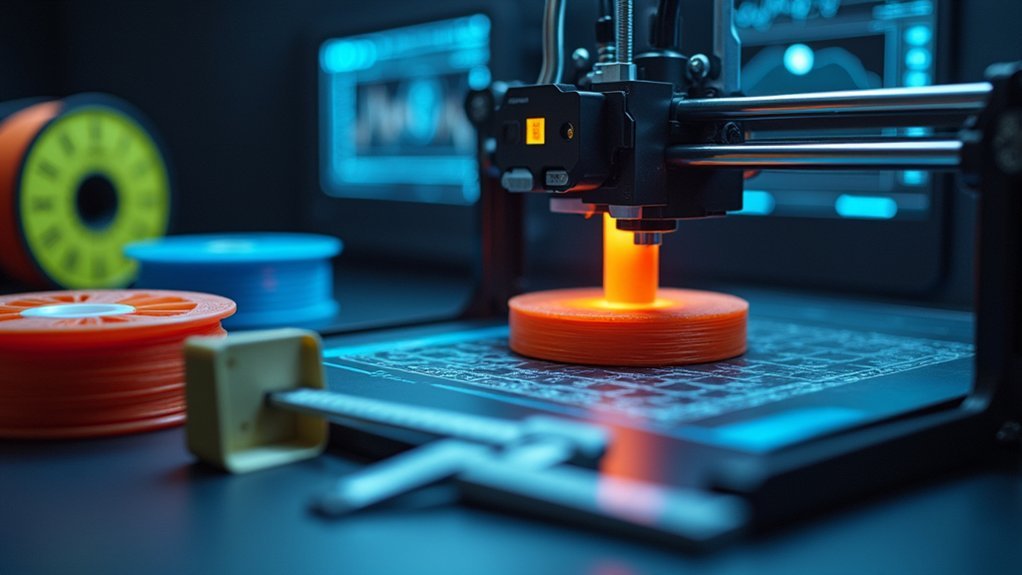Start your linear advance calibration with moderate base speeds of 30-50 mm/s to detect K-factor effects accurately. Use significant speed differences—set fast speeds above 80 mm/s and slow speeds below 40 mm/s for at least 50% variation between test lines. Test multiple K-values (10, 20, 30) while adjusting acceleration settings to isolate linear advance effects. Create 100mm straight segments for full speed achievement and monitor corner quality at higher speeds. These fundamentals will reveal advanced calibration techniques that dramatically improve your print consistency.
Start With Moderate Base Speeds for Accurate K-Factor Detection

When you’re calibrating linear advance, you’ll want to start with moderate speeds between 30-50 mm/s since these speeds provide the sweet spot for detecting K-factor effects without creating excessive pressure fluctuations that can mask your results.
These moderate speeds allow you to observe clear differences in corner sharpness and extrusion consistency as you adjust your K-factor values. Starting around a K-factor of 10 gives you a baseline that typically shows visible changes without causing severe under or over-extrusion.
You’ll notice that faster speeds can hide subtle calibration issues, while slower speeds won’t reveal the full impact of linear advance adjustments. This balanced approach guarantees you can accurately assess print quality improvements and make precise K-factor adjustments.
Use Significant Speed Differences Between Fast and Slow Test Lines
To maximize the visibility of K-factor effects during calibration, you’ll need significant speed differences between your test lines—ideally at least 50% variation to create distinct extrusion behaviors.
Set your Fast Printing Speed above 80 mm/s and your Slow Printing Speed below 40 mm/s to observe contrasting extrusion patterns clearly. This substantial difference reveals under-extrusion or over-extrusion issues that subtle speed variations might miss.
When speeds differ dramatically, you’ll see distinct print lines that make K-factor adjustments more apparent.
Space your test lines adequately to prevent overlap, allowing better comparison between fast and slow results.
Include longer line lengths at these contrasting speeds—this extended printing helps reveal how K-factor variations impact overall print quality throughout the extrusion process.
Adjust Acceleration Settings to Isolate Linear Advance Effects

You’ll want to manipulate your acceleration settings strategically to isolate linear advance effects from other variables that can muddy your calibration results.
Setting acceleration to zero creates the cleanest testing environment, as it eliminates deceleration and acceleration influences that can mask the true impact of your K-factor adjustments.
Finding the right balance between print speed and acceleration settings lets you clearly observe how different K-values affect your print quality without interference from constantly changing movement dynamics.
Zero Acceleration Testing Method
Although most Linear Advance calibration occurs with normal acceleration settings, reducing acceleration to zero creates a perfect testing environment that isolates the K-factor’s impact on pressure control.
You’ll eliminate acceleration and deceleration dynamics that can mask Linear Advance effects during calibration tests. Set your print head to move at a consistent slow speed of 100mm/s with 0.50mm wall thickness using a 0.40mm nozzle for optimal observation.
This controlled approach lets you focus exclusively on how different K-values compensate for pressure fluctuations during extruder starts and stops.
Monitor corner tightness and banding carefully as you test various K-factor settings. Document your findings thoroughly, as this zero-acceleration data helps refine K-values for different filaments and improves overall print quality across various scenarios.
Speed Vs Acceleration Balance
While zero acceleration testing provides excellent baseline data, finding the right speed-acceleration balance becomes critical for real-world Linear Advance calibration. You’ll need to adjust acceleration settings strategically to see Linear Advance’s true impact on your prints.
High acceleration can mask Linear Advance benefits by reducing time spent at higher speeds where under-extrusion occurs. Set your print speed considerably higher than test speeds to observe K-factor effects on corner tightness and banding.
| Print Speed | Acceleration | Linear Advance Visibility |
|---|---|---|
| 60mm/s | 3000mm/s² | Poor |
| 80mm/s | 1500mm/s² | Good |
| 100mm/s | 1000mm/s² | Excellent |
| 120mm/s | 800mm/s² | Excellent |
| 150mm/s | 500mm/s² | Outstanding |
This balanced approach guarantees you’re calibrating Linear Advance under conditions that reveal its actual performance impact.
Optimize Print Pattern Length for Full Speed Achievement
When calibrating Linear Advance, your test pattern’s length becomes critical because the extruder needs sufficient distance to reach its full operating speed. Without adequate print pattern length, you’ll get inaccurate readings that compromise effective testing results.
Your calibration pattern requires strategic design considerations:
- Minimum 100mm straight segments – This guarantees your extruder reaches full speed for accurate K-factor assessment
- 5mm priming lines – Account for initial pressure build-up before main test lines begin
- 5-10mm line spacing – Optimize visibility between different K-factor values for clearer comparison
- Alternating layer directions – Use clockwise/counterclockwise patterns to reduce non-uniformities
Longer straight segments minimize acceleration and deceleration interference, allowing you to evaluate true Linear Advance effects.
This approach delivers superior extrusion consistency and more reliable calibration results.
Monitor Corner Quality and Banding at Higher Speeds

Higher printing speeds reveal Linear Advance calibration issues that remain hidden at slower velocities.
You’ll notice corner quality deteriorates first, with visible gaps or divots appearing where walls meet. These corner defects become pronounced when your K-factor isn’t optimized for increased speeds, creating under-extrusion in tight turns.
Watch for banding patterns across your print surfaces, as they intensify with speed when Linear Advance settings are incorrect. Uneven extrusion creates visible striping that compromises print quality markedly.
Test with substantial speed differences—100mm/s versus 30mm/s—to make K-factor effects obvious.
Focus on your first few layers, where corner tightness and surface finish differences are most apparent. Document correlations between specific K-values and speed-related defects to optimize your calibration effectively.
Test Multiple K-Values Across Different Speed Ranges
You’ll need to establish a significant speed differential of at least 30-50 mm/s between your fast and slow test prints to make K-factor effects clearly visible.
Start with a K-value range from 0.0 to 1.0 in 0.1 increments, then narrow down based on your initial results.
Pay close attention to how each K-value performs during acceleration and deceleration phases, as these shifts reveal the most about your printer’s extrusion consistency.
Speed Differential Requirements
Creating an adequate speed differential between your fast and slow printing speeds is essential for accurate Linear Advance calibration, as insufficient variation won’t reveal the true effects of different K-values on your prints.
You’ll need at least a 50% speed difference to make K-factor changes visible. Without proper speed differential, you won’t see how effectively each K-value compensates for pressure fluctuations during acceleration and deceleration phases.
Consider these speed differential requirements:
- Minimum 50% difference between slow and fast speeds for ideal K-value visibility
- Test speeds like 30 mm/s slow and 60 mm/s fast to observe clear performance differences
- Adjust line distances based on speed settings to maintain print quality clarity
- Monitor both speeds equally to identify the K-value that best balances extrusion consistency
K-Value Range Selection
Multiple K-values must be tested across different speed ranges to determine the ideal Linear Advance setting for your specific printing conditions.
You’ll want to select a K-value range covering at least three distinct settings, such as 10, 20, and 30, to identify optimal performance across varying print speeds.
Your extrusion behavior changes considerably between fast and slow printing speeds, making it essential to test each K-value at both extremes. The difference between speeds should be substantial enough to make K-factor effects clearly visible during calibration.
Remember that your ideal K-factor varies based on filament type, nozzle size, and printing temperature.
Monitor results closely at each speed with specific K-values to pinpoint the ideal combination that minimizes under-extrusion and excess material issues.
Acceleration Impact Testing
When acceleration settings interfere with Linear Advance calibration, they’ll mask the true effects of your K-values and produce misleading results.
You’ll need to isolate Linear Advance by temporarily setting acceleration to zero during testing.
To properly evaluate acceleration impact on your calibration:
- Set acceleration to zero during initial K-value testing to eliminate external influences
- Test with significant speed differences between fast and slow printing phases for clear observations
- Monitor corner tightness and banding at different K-values to identify ideal settings
- Calculate total print width including fast speed length, slow speed length, and priming line for accurate assessment
After determining your baseline K-values, gradually reintroduce normal acceleration settings.
This methodology guarantees your Linear Advance compensates properly for extrusion lag, delivering consistent print quality across varying speeds.
Fine-Tune Speed Settings Based on Filament and Nozzle Specifications
Because different filament types respond uniquely to temperature and pressure changes, you’ll need to adjust your calibration speed accordingly to achieve perfect linear advance results.
Filament-specific calibration speeds are essential for achieving optimal linear advance performance across different material types.
For PLA, use slower speeds around 30-50 mm/s to prevent pressure inconsistencies. PETG and ABS handle faster speeds up to 100 mm/s effectively.
Your 0.4 mm nozzle works best with 60 mm/s print speeds for ideal K-factor adjustments.
Maintain your extruded line width between 1.05 and 1.2 times your nozzle diameter to guarantee extrusion consistency.
Create significant speed differences—at least 40 mm/s between fast and slow settings—to clearly observe K-factor effects.
Run thorough tests with various speed and K-value combinations to assess how each setting impacts print quality and extrusion performance.
Frequently Asked Questions
Can I Use Linear Advance Calibration Speeds for All Printer Models?
You can’t use identical calibration speeds across all printer models. Each printer’s unique mechanics, hotend design, and extruder specifications require specific speed settings. You’ll need to adjust calibration speeds based on your printer’s capabilities and limitations.
Should I Recalibrate Linear Advance When Switching Between Different Extruder Types?
Yes, you’ll need to recalibrate linear advance when switching extruder types. Different extruders have varying pressure characteristics, bowden tube lengths, and mechanical properties that directly affect how filament flows during acceleration changes.
How Does Ambient Temperature Affect Optimal Linear Advance Calibration Speeds?
You’ll need slower calibration speeds in colder environments since filament flows differently. Higher ambient temperatures let you use faster speeds because the material’s more pliable and responsive to pressure changes.
Do Direct Drive and Bowden Setups Require Different Calibration Approaches?
Yes, you’ll need different approaches since direct drive systems respond faster with lower K-factors, while bowden setups require higher values due to filament compression in the longer tube pathway.
Can I Automate Linear Advance Calibration or Must It Be Manual?
You can automate linear advance calibration using test towers or gcode scripts that print different K-factor values. However, you’ll still need to manually evaluate print quality to determine the ideal setting.





Leave a Reply